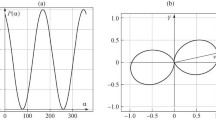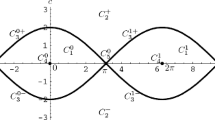Abstract
Two-dimensional time-optimal paths of objects moving under the influence of an external force are discussed based on an analysis of Jacobi stability in Finsler space. When the external force on an object can be described by a function of only one variable, the deviation curvature tensor that determines the Jacobi stability of the object’s path can be obtained from the equation of the path. In such cases, the Jacobi stability of the path is represented by the trace of the deviation curvature tensor. The relationship between the Jacobi stability and the type of path is considered for a force that is described by a single-variable trigonometric function. This type of periodic external force induces a path that extends radially and a path along in a specific direction. Then, we consider the time-averaged eigenvalues of the deviation curvature tensor for each type. A large peak in these average values is observed when the type of path changes. Therefore, the Jacobi instability becomes very large at the boundaries between the path types, and the Jacobi stability analysis can be used as the basis of a classification of the path types.








Similar content being viewed by others
References
Abolghasem, H.: Jacobi stability of Hamiltonian systems. Int. J. Pure Appl. Math. 87, 181–194 (2013)
Aldea, N., Kopacz, P.: Generalized Zermelo navigation on Hermitian manifolds with a critical wind. Results Math. 72, 2165–2180 (2017)
Aldea, N., Kopacz, P.: Time-optimal navigation in arbitrary winds. Annu. Rev. Control. 49, 164–172 (2020)
Aldea, N., Kopacz, P.: Time-extremal navigation in arbitrary winds on conformally flat Riemannian manifolds. J. Optim. Theory Appl. 189, 19–45 (2021)
Aldea, N., Kopacz, P.: Time geodesics on a slippery slope under gravitational wind. Nonlin. Anal. 227, 113160 (2023)
Antonelli, P.L., Ingarden, R.S., Matsumoto, M.: The Theory of Sprays and Finsler Spaces with Applications in Physics and Biology. Kluwer Academic Publishers, Dordrecht (1993)
Antonelli, P.L., Bucataru, I.: Volterra-Hamilton production models with discounting: general theory and worked examples. Nonlin. Anal. RWA 2, 337–356 (2001)
Antonelli P.L., Bucataru, I.: KCC theory of a system of second order differential equations. In: Antonelli, P.L. (ed.): Handbook of Finsler Geometry, vol. 1, pp. 83-174. Kluwer Academic Publishers, Dordrecht (2003)
Antonelli, P.L., Bevilacqua, L., Rutz, S.F.: Theories and models in symbiogenesis. Nonlin. Anal. RWA 4, 743–753 (2003)
Bakolas, E., Tsiotras, P.: Optimal partitioning for spatiotemporal coverage in a drift field. Automatica 49, 2064–2073 (2013)
Bao, D., Robles, C., Shen, Z.: Zermelo navigation on Riemannian manifolds. J. Differ. Geom. 66, 377–435 (2004)
Biferale, L., Bonaccorso, F., Buzzicotti, M., Di Leoni, P.C., Gustavsson, K.: Zermelo’s problem: optimal point-to-point navigation in 2D turbulent flows using reinforcement learning. Chaos 29, 103138 (2019)
Böhmer, C.G., Harko, T.: Nonlinear stability analysis of the Emden–Fowler equation. J. Nonlinear Math. Phys. 17, 503–516 (2010)
Böhmer, C.G., Harko, T., Sabau, S.V.: Jacobi stability analysis of dynamical systems - applications in gravitation and cosmology. Adv. Theor. Math. Phys. 16, 1145–1196 (2012)
Bonnard, B. Cots., O., Wembe, B.: A Zermelo navigation problem with a vortex singularity. ESAIM Control Optim. Calc. Var. 27, S10 (2021)
Brody, D.C., Meier, D.M.: Solution to the quantum Zermelo navigation problem. Phys. Rev. Lett. 114, 100502 (2015)
Brody, D.C., Gibbons, G.W., Meier, D.M.: Time-optimal navigation through quantum wind. New J. Phys. 17, 033048 (2015)
Cartan, E.: Observations sur le mémoire précédent. Math. Z. 37, 619–622,: (Extrait d’une lettre à M. D. D. Kosambi) (1933)
Chern, S.-S.: Sur la géométrie d’un système d’équations différentielles du second ordre. Bull. Sci. Math. 63, 206–212 (1939)
Emerson, S.R., Hedges, J.I.: Chemical Oceanography and the Marine Carbon Cycle. Cambridge University Press, Cambridge (2008)
Gibbons, G.W., Herdeiro, C.A.R., Warnick, C.M., Werner, M.C.: Stationary metrics and optical Zermelo–Randers–Finsler geometry. Phys. Rev. D 79, 044022 (2009)
Gupta, M.K., Yadav, C.K.: Jacobi stability analysis of Rikitake system. Int. J. Geom. Methods Mod. Phys. 13, 1650098 (2016)
Gupta, M.K., Yadav, C.K.: Jacobi stability analysis of Rössler system. Int. J. Bifurc. Chaos 27, 1750056 (2017)
Harko, T., Ho, C.Y., Leung, C.S., Yip, S.: Jacobi stability analysis of the Lorenz system. Int. J. Geom. Methods Mod. Phys. 12, 1550081 (2015)
Hirakui, Y., Yajima, T.: Geometrical classification of self-similar motion of two-dimensional three point vortex system by deviation curvature on Jacobi field. Adv. Math. Phys. 2021, 9979529 (2021)
Hubicska, B., Muzsnay, Z.: Holonomy in the quantum navigation problem. Quantum Inf. Process. 18, 325 (2019)
Kopacz, P.: Application of planar Randers geodesics with river-type perturbation in search models. Appl. Math. Model. 49, 531–553 (2017)
Kopacz, P.: A note on time-optimal paths on perturbed spheroid. J. Geom. Mech. 10, 139–172 (2018)
Kopacz, P.: On generalization of Zermelo navigation problem on Riemannian manifolds. Int. J. Geom. Methods Mod. Phys. 16, 1950058 (2019)
Kosambi, D.D.: Parallelism and path-spaces. Math. Z. 37, 608–618 (1933)
Li, B., Xu, C., Teo, K.L., Chu, J.: Time optimal Zermelo’s navigation problem with moving and fixed obstacles. Appl. Math. Comput. 224, 866–875 (2013)
Oiwa, S., Yajima, T.: Jacobi stability analysis and chaotic behavior of nonlinear double pendulum. Int. J. Geom. Methods Mod. Phys. 14, 1750176 (2017)
Oliver, J.E. (ed.): Encyclopedia of World Climatology. Springer, Dordrecht (2005)
Peterson, J.T.A., Singh, S.K., Junkins, J.L., Taheri, E.: Lyapunov guidance in orbit element space for low-thrust cislunar trajectories. In: AAS Guidance, Navigation and Control Conference held January 30–February 5, 2020, Breckenridge, Colorado, USA, AAS 20-115 (2020)
Sabau, S.V.: Some remarks on Jacobi stability. Nonlin. Anal. TMA 63, e143–e153 (2005)
Sabău, V.S.: Systems biology and deviation curvature tensor. Nonlin. Anal. RWA 6, 563–587 (2005)
Shen, Z.: Differential Geometry of Spray and Finsler Spaces. Kluwer Academic Publishers, Dordrecht (2001)
Shiller, Z.: On singular time-optimal control along specified paths. IEEE Trans. Robot. Autom. 10, 561–566 (1994)
Singh, S.K., Taheri, E., Junkins, J.: A hybrid optimal control method for time-optimal slewing maneuvers of flexible spacecraft. In: AAS/AIAA Astrodynamics Specialist Conference held August 19–23, 2018, Snowbird, Utah, USA, AAS 18-331 (2018)
Singh, S.K., Anderson, B.D., Taheri, E., Junkins, J.L.: Low-thrust transfers to southern \(L_{2}\) near-rectilinear halo orbits facilitated by invariant manifolds. J. Optim. Theory Appl. 191, 517–544 (2021)
Yajima, T., Nagahama, H.: KCC-theory and geometry of the Rikitake system. J. Phys. A: Math. Theor. 40, 2755–2772 (2007)
Yajima, T., Nagahama, H.: Geometrical invariants of Rikitake system in KCC-theory. Tensor (N.S.) 69, 106–113 (2008)
Yajima, T., Nagahama, H.: Nonlinear dynamical systems and KCC-theory. Acta Math. Acad. Paedagog. Nyházi. 24, 179–189 (2008)
Yajima, T., Nagahama, H.: Geometrical unified theory of Rikitake system and KCC-theory. Nonlin. Anal. TMA 71, e203–e210 (2009)
Yajima, T., Nagahama, H.: Tangent bundle viewpoint of the Lorenz system and its chaotic behavior. Phys. Lett. A 374, 1315–1319 (2010)
Yajima, T., Nagahama, H.: Finsler geometry for nonlinear path of fluids flow through inhomogeneous media. Nonlin. Anal. RWA 25, 1–8 (2015)
Yajima, T., Nakase, S.: A geometric interpretation of maximal Lyapunov exponent based on deviation curvature. Int. J. Geom. Methods Mod. Phys. 18, 2150092 (2021)
Yajima, T., Yamasaki, K.: Jacobi stability for dynamical systems of two-dimensional second-order differential equations and application to overhead crane system. Int. J. Geom. Methods Mod. Phys. 13, 1650045 (2016)
Yamasaki, K., Yajima, T.: KCC analysis of the normal form of typical bifurcations in one-dimensional dynamical systems: geometrical invariants of saddle-node, transcritical, and pitchfork bifurcations. Int. J. Bifurc. Chaos 27, 1750145 (2017)
Yamasaki, K., Yajima, T.: Lotka-Volterra system and KCC theory: differential geometric structure of competitions and predations. Nonlin. Anal. RWA 14, 1845–1853 (2013)
Yamasaki, K., Yajima, T.: KCC analysis of a one-dimensional system during catastrophic shift of the Hill function: Douglas tensor in the nonequilibrium region. Int. J. Bifurc. Chaos 30, 2030032 (2020)
Zermelo, E.: Über das Navigationsproblem bei ruhender oder veränderlicher Windverteilung. Z. Angew. Math. Mech. 11, 114–124 (1931)
Acknowledgements
The authors are deeply grateful to Mr. Kouhei Takagi and Mr. Yuuki Takagi for their insightful comments and discussions on the time-optimal problem in Finsler space. This work was supported by JSPS KAKENHI Grant Number 23K03226.
Author information
Authors and Affiliations
Corresponding author
Additional information
Communicated by Vincenzo Capasso.
Publisher's Note
Springer Nature remains neutral with regard to jurisdictional claims in published maps and institutional affiliations.
Appendix A: Geometrical Quantities Obtained From Finsler Function with Periodic External Forces
Appendix A: Geometrical Quantities Obtained From Finsler Function with Periodic External Forces
In this Appendix, we describe the geometrical quantities obtained from Finsler function (2) with the external forces for cases (A) and (B).
1.1 Geometrical Quantities in Case of External Force (A)
First, the geometrical quantities are considered for case (A). The coefficients of the nonlinear connection are given by the functions \(G^{1}\) and \(G^{2}\):
where we put the coefficients in the nonlinear connection as
The coefficients of the Berwald connection \(G^{i}_{jk}\) are given by
Here, the coefficients in the Berwald connection are defined by
1.2 Geometrical Quantities in Case of External Force (B)
The geometrical quantities of the external force for case (B) can be obtained as case for (A). The coefficients of the nonlinear connection are given by the functions \(G^{1}\) and \(G^{2}\):
where we put the coefficients in the nonlinear connection as
The coefficients of the Berwald connection \(G^{i}_{jk}\) are given by
Here, the coefficients in the Berwald connection are defined by
Rights and permissions
Springer Nature or its licensor (e.g. a society or other partner) holds exclusive rights to this article under a publishing agreement with the author(s) or other rightsholder(s); author self-archiving of the accepted manuscript version of this article is solely governed by the terms of such publishing agreement and applicable law.
About this article
Cite this article
Yajima, T., Tazawa, Y. Classification of Time-Optimal Paths Under an External Force Based on Jacobi Stability in Finsler Space. J Optim Theory Appl 200, 1216–1238 (2024). https://doi.org/10.1007/s10957-023-02374-2
Received:
Accepted:
Published:
Issue Date:
DOI: https://doi.org/10.1007/s10957-023-02374-2
Keywords
- Optimal control
- Classification of time-optimal paths
- Finsler geometry
- Deviation curvature tensor
- Jacobi stability




